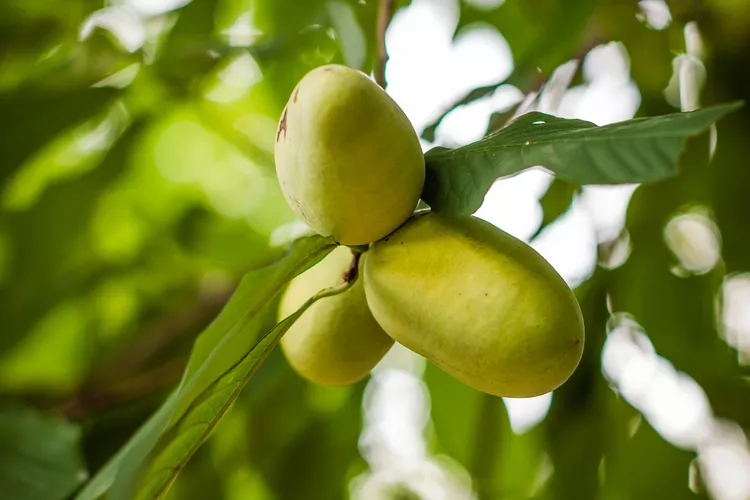The pawpaw (Asimina triloba) is a small tree native to the eastern United States. It has a decidedly tropical look to it because of its large leaves, and it produces some of the most exotic-flavored fruit of any fruit tree in North America. In spring, dark purple flowers are followed by green sausage-shaped fruits in late summer to early fall that taste somewhat like a mixture of banana and mango fruit. Their consistency is similar to a ripe avocado with a very smooth texture, making them great for eating with a spoon.
Over the past few years, interest in pawpaws has grown considerably, but finding out how to grow a pawpaw tree and even where to buy the plants have been somewhat elusive for gardeners. In the wild, pawpaw trees often grow in lowland thickets and slowly spread underground by suckers, producing a group of genetically identical trees. Here's what you need to know to grow a pawpaw tree in your yard.
Pawpaw Tree Overview
| Genus Name | Asimina triloba |
| Common Name | Pawpaw Tree |
| Plant Type | Tree |
| Light | Sun |
| Height | 15 to 30 Feet |
| Width | 15 to 30 Feet |
| Flower Color | Purple |
| Foliage Color | Blue/Green |
| Season Features | Colorful Fall Foliage |
| Zones | 5, 6, 7, 8, 9 |
| Propagation | Grafting, Seed, Stem Cuttings |
Where to Plant Pawpaw Trees
Pawpaw can be planted as specimen plants, in home orchards, or in rain gardens. Unlike many other trees, they tolerate being planted around black walnut trees, which produce a chemical that can inhibit growth.
How and When to Plant Pawpaws
The best time to plant a pawpaw tree is in spring. While fertilizers are not necessary, feeding newly planted trees with a general-purpose fertilizer once a month for the first growing season will help to quickly establish trees. Planting pawpaws is similar to planting most other types of trees:
- Begin by digging a hole twice the size of the root ball.
- Place the tree in a hole and backfill soil into the hole, ensuring that the tree remains upright and the existing soil level is maintained. If the tree is bare-root, note soil marking on the bark of the tree too, and be sure to fully cover the roots.
- Water the tree thoroughly to remove air pockets and add additional soil as necessary.
Warning
Pawpaw fruit is edible, but only the soft inside. Avoid eating the skin or seeds of the fruit due to the presence of annonacin, which is toxic.
Pawpaw Care Tips
Light
Pawpaws are tolerant of light shade but produce stronger stems and more fruit when planted in full-sun locations. Some shade can be helpful to younger trees while they become established.
Soil and Water
Pawpaws are generally found in low-lying areas in loamy, acidic, and moist soil, making them ideal for regularly watered rain gardens and low spots in the yard.
Temperature and Humidity
As natives of the eastern half of the United States, these trees do just fine with hot summers, cold winters, and plenty of precipitation and humidity.
Fertilizer
Feeding your trees is not necessary in their native soils, but a general-purpose fertilizer applied once a month while establishing plants and then one to two times a year thereafter can be beneficial.
Pruning
Pruning pawpaws isn’t necessary, but trimming lower branches, crossed or broken branches, and removing suckers from around parent trees can help to keep the area tidy. Any pruning should be done in late winter to early spring, just before growth resumes. Trimming will lower fruit production the following year.
Pests and Problems
Pawpaws are hardy once established, but can succumb to powdery mildew. Treatments with organic pesticides such as neem oil or copper fungicides can help keep this disease under control. Providing ample airflow around the tree can help to reduce infections, too.
Pawpaw fruit is favored by wildlife such as raccoons, and netting or caging can be helpful to secure crops. Native zebra swallowtails feed on the leaves of pawpaws, but the caterpillars will not permanently harm healthy trees and should be left alone.
How to Propagate Pawpaws
Pawpaws can be reliably propagated by grafting and sowing seeds. However, seedlings and young trees can be difficult to establish. Purchasing larger trees when available will help to ensure healthy and vigorous trees.
Companion Plants for Pawpaws
As natives, pawpaw do well with a variety of native trees, shrubs, and perennials. When planted in rain gardens, choose other water lovers such as sedges (Carex spp.), dogwoods (Cornus spp.), and swamp milkweed (Asclepias incarnata).




















